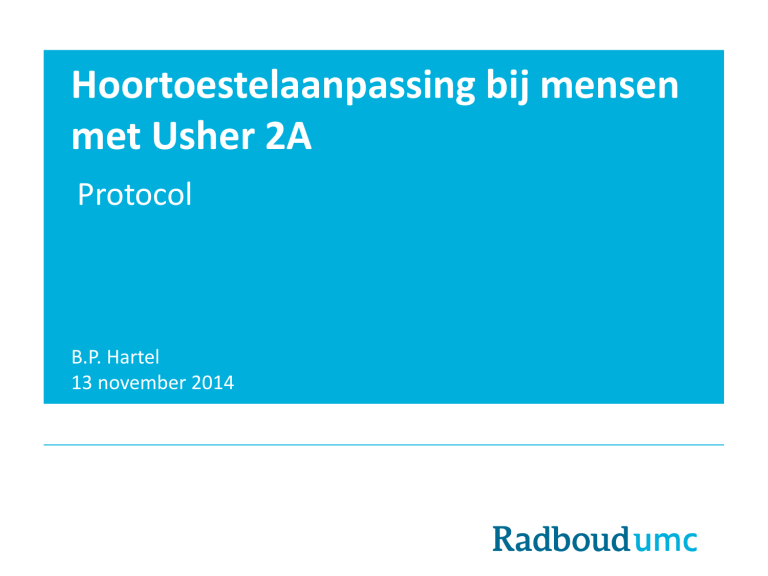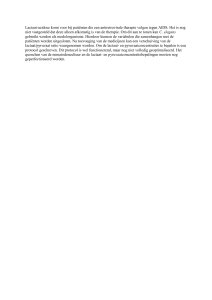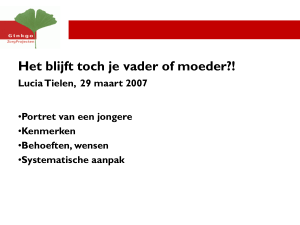
Hoortoestelaanpassing bij mensen
met Usher 2A
Protocol
B.P. Hartel
13 november 2014
Inhoud
• Vraagstelling
• Project
• Hypotheses
• Methoden
• Interpretatie
• Discussie
• Equipe
• Contactgegevens
Vraagstelling
Hypotheses
Selectie
Vraagstelling
Protocol
Testen
Resultaten
Interpretatie
Vraagstelling
Hypotheses
Selectie
Vraagstelling
Protocol
Testen
Resultaten
Interpretatie
Vraagstelling
Hypotheses
Selectie
Protocol
Testen
Resultaten
Interpretatie
Hypotheses
• Hypothese 1: Een persoon met Usher 2A heeft meer profijt van een nonlineair programma bij spraakverstaan in ruis in vergelijking met een lineair
programma.
• Hypothese 2: Een persoon met Usher 2A heeft meer profijt van een lineair
programma bij geluidslokalisatie in het horizontale vlak in vergelijking met
een non-lineair programma.
Vraagstelling
Hypotheses
Selectie
Protocol
Testen
Resultaten
Geluidslokalisatie horizontale vlak
Tonen
Frequentie (Hz)
Lage frequenties
tot ong. 1500
Tijdsverschil (ITD)
Hoge frequenties
boven ong. 3000
Luidheidverschil (ILD)
• Geluidslokalisatie verticale vlak minder van toepassing bij deze groep:
• Spectrale cues van hoogfrequente geluiden
• Usher 2A verlies voornamelijk in hoge frequenties
• Plaats microfoon en dicht oorstukje
o.a. van opstal en Hoffman, 1998
Interpretatie
Vraagstelling
Hypotheses
Selectie
Protocol
Testen
Resultaten
Interpretatie
Hypothese 2
• Lineair
• Geen verstoring van ILD en ITD?
• Non-lineair, Wide Dynamic Range MultiChannel Compression (WDRMCC)
• Versterking bij elk oor wordt aangepast (verstoring ILD)
• Dynamische compressie (verstoring ITD)
• Directionele microfoon
• Dempt geluiden van zijkanten
Simon H et al. 2007
Vraagstelling
Hypotheses
Selectie
Protocol
Subjecten: Usher 2A
•
•
•
•
Testen
Resultaten
Syndroom van Usher type IIA
Autosomaal recessief syndroom
80% van Usher type II heeft mutatie in USH2A gen
Congenitaal slechthorend en Retinitis pigmentosa in tienerjaren
Pennings RJ et al. 2003
Interpretatie
Vraagstelling
Hypotheses
Selectie
Inclusie criteria
• 2 bekende mutaties in USH2A
• > 18 jaar
• PTA (0.5, 1, 2, 4 kHz) < 80 dBHL
Protocol
Testen
Resultaten
Interpretatie
Vraagstelling
Hypotheses
Selectie
Hoortoestellen
• Phonak Naida Q90 SP/UP
Protocol
Testen
Resultaten
Interpretatie
Vraagstelling
Hypotheses
Selectie
Protocol
Programma’s : Lineair
Testen
Resultaten
Interpretatie
Vraagstelling
Hypotheses
Selectie
Protocol
Testen
Programma’s: Non-lineair
Resultaten
Interpretatie
Vraagstelling
Hypotheses
Selectie
Protocol
Testen
Uitkomsten
• Objectief
• Spraak in ruis ratio (SNR)
• Accuratesse geluidslokalisatie
• Subjectief
• Abreviated Profile of Hearing Aid benefit (APHAB)
• Glasgow Hearing Aid Difference Profile (GHADP)
• Dagboek
2 Meetmomenten: acuut vs. na 7 weken
Resultaten
Interpretatie
Vraagstelling
Hypotheses
Selectie
Protocol
Testen
Resultaten
Interpretatie
Spraak in ruis : de Matrix test
•
•
•
•
Grammaticaal correcte zinnen bestaande uit 5 woorden.
Naamwoord + werkwoord + telwoord + bijvoeglijk naamwoord + voorwerp
Herkenbaarheid van Plomp zinnen mogelijk hoger in deze patiëntengroep
SNR beter internationaal vergelijkbaar
Dreschler W.A. et al. 2006 ; Houben R. et al. 2014
Vraagstelling
Hypotheses
Selectie
Protocol
Testen
Resultaten
Spraak in ruis : de Matrix test
Interpretatie
Vraagstelling
Hypotheses
Selectie
Protocol
Testen
Geluidslokalisatie: de Boog
Website Prof. J. v. Opstal
http://www.mbfys.ru.nl/~johnvo/localisatie/localisatie.html#top
Resultaten
Interpretatie
Vraagstelling
Hypotheses
Selectie
Protocol
Testen
Resultaten
Spraak in ruis : de Matrix test
• Condities
Spraak: altijd van voren (0 graden)
Ruis: afwisselend van voren of van de zijkant (-90 of +90 graden)
Interpretatie
Vraagstelling
Hypotheses
Selectie
Protocol
Testen
Geluidslokalisatie: de Boog
• Condities
Resultaten
Interpretatie
Vraagstelling
Hypotheses
Selectie
Protocol
Testen
Resultaten
Interpretatie
Geluidslokalisatie: voorbeeld uitslag
Website Prof. J. v. Opstal
http://www.mbfys.ru.nl/~johnvo/localisatie/localisatie.html#top
Vraagstelling
Hypotheses
Selectie
Protocol
Testen
Resultaten
Interpretatie
Interpretatie
• Mogelijke aanbevelingen/protocol voor het kiezen en aanmeten van
hoortoestellen bij Usher 2A.
Discussie
• Verdere optimalisatie na resultaten
• Toepasbaarheid op andere (grotere) groep doofblinden.
• Nieuw onderzoek nodig bij binauraal communicerende hoortoestellen
E. Borg et al, Monitoring the environment: Sound localization equipment for deaf-blind people, 1999
H. Simon et al, Effect of Dual Sensory Loss on Audiotory Localization: Implications for intervention, 2007
Mede mogelijk gemaakt door:
•
•
•
•
•
•
•
Radboudumc
Afdeling Biofysica, Donders instituut
Phonak
Nuts-Ohra Fonds
Innovatiefonds Zorgverzekeraars
Stichting Het Heinsius-Houbolt Fonds
Patiënten
Equipe
Bas
Hartel 1
Ronald
Arjan
Martijn
Pennings 1 Bosman 1 Agterberg 2
Ad
Snik 1
John
van Opstal 2
Afdeling KNO, Radboud University Nijmegen Medical Centre, Donders Institute for
Brain, Cognition and Behavior, The Netherlands
2
Afdeling Biofysica, Donders Institute for Brain, Cognition and Behavior, Radboud
University Nijmegen, Nijmegen, The Netherlands
1
Contactgegevens
Bas Hartel
Arts-onderzoeker Keel-, Neus- en Oorheelkunde
E-mail: [email protected]
Tel: 024-3666217
Radboud Universitair Medisch Centrum
Afdeling Keel- Neus- en Oorheelkunde
Huispost 377
Postbus 9101
6500 HB Nijmegen
http://en.wikipedia.org/wiki/Accuracy_and_precision











